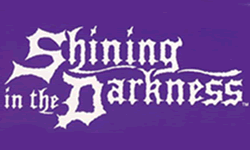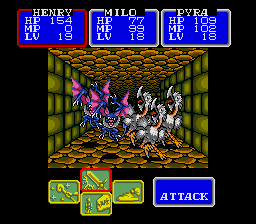|
|

|
BATTLE SYSTEM
|

|
INTERACTION
|

|
ORIGINALITY
|

|
STORY
|

|
MUSIC & SOUND
|

|
VISUALS
|

|
CHALLENGE
|
Medium
|
COMPLETION TIME
|
15-30 Hours
|
|
OVERALL
3.0/5
|
Rating definitions
|
|
|
In the Kingdom of Thornwood, the knight Sir Mortred and Princess Jessa are visiting the Queen's Shrine, only to vanish mysteriously. Shining in the Darkness follows the quest by Sir Mortred's son to find out what exactly happened to his father and the princess, and battle the evil Dark Sol. Though it has its flaws, Shining in the Darkness was nonetheless an okay start for Sega's diverse Shining series.
On his quest through the game's giant labyrinth, the hero must battle endless hordes of monsters with his two friends, Milo and Pyra. The battle system in Shining in the Darkness is, for the most part, standard turn-based fare: input a command, including attack, defend, item, or magic, for each character, and they and the enemy take their turns depending on their speed; the player can also try to escape, although this option, naturally, isn't foolproof. Only Milo and Pyra can use magic, with the former gaining mostly healing spells and the latter gaining mostly offensive spells; while they occasionally gain higher levels for their spells, the player can freely adjust spell level for lessened MP consumption if desired.
 The Labyrinth--where you'll spend 95% of the game
The Labyrinth--where you'll spend 95% of the game
|
|
Normal battles, mercifully, rarely exceed a minute, especially if players don't use normal attacks all the time. If players happen to die, though, the game doesn't dump them back to the title screen; rather, vakyries take the player's party back to the main town's shrine for revival before making off with half their gold. Since the town shrine is the only save point, that the game is actually nice to players when they die is a bit of a blessing. Other features include the occasional weapon that characters can use to cast spells in battle, which, however, gradually wear down, and break if overused, and material that the trader, who comes to town late in the game, can forge into equipment for characters; the trader can also repair weapons usable as items as long as they haven't completely broken.
Shining in the Darkness, for the most part, is balanced in terms of difficulty, which frankly depends on the player's skill with the battle system and how high the party's levels are. In the end, the battle system, despite its relative conservatism, is fairly enjoyable, with the only real shortcoming being the somewhat-high encounter rate, although a spell can temporarily nullify encounters with enemies if the party's levels are high enough (if not, the aforementioned spell won't work at all).
Interaction, however, could've used a bit of work. The menus are largely manageable, and there is a consumable item, in addition to a spell, providing easy exit from the main dungeon, not to mention a special item that allows for rapid conveyance to certain areas of the labyrinth and a spell letting players view a map of visited parts of the game's giant first-person dungeon, although there are several irritations. For one, shopping for items requires endless confirmations, and players can't see how new equipment affects their stats before buying it, or item or spell effects, for that matter. Your characters have limited inventories, as well; though this adds to the effectiveness of the battle system by limiting the amount of items they can carry into combat, it creates of the problem of having to discard items constantly to acquire the contents of treasure chests. Furthermore, the translation, while legible, contains several glaring errors, and ultimately, interaction leaves plenty of room for improvement.
 That the series has gone downhill today? Yes.
That the series has gone downhill today? Yes.
|
|
Although Shining in the Darkness was one of the very first console "dungeon crawlers" and the first of the Shining series, it really didn't bring much new to the genre in its time; first-person dungeons have been in previous RPGs such as Phantasy Star, and its turn-based battle system, aside from adjustable spell level, wasn't terribly inventive.
The story, as with most other RPGs at the time, pretty much takes a backseat to the gameplay, given the deficit of story scenes and character development, although there are maybe one or two minor twists. It's never a good thing, however, when merchants get more dialogue than the main characters in RPGs, and overall, it's obvious that the writers should've given the plot a more thorough once-over.
The sound quality of the Sega Genesis has never been on par with the Super NES's, although the music in Shining in the Darkness is still okay, even if repetitive and a bit painfully instrumented. Sound effects, furthermore, lack diversity, and all in all, the aurals are middling.
The visuals aren't spectacular, yet aren't terrible, either. Rather than relying on character sprites, Shining in the Darkness relies mostly on fully-proportional anime-style character and monster designs. These models, however, are a little on the sloppy side, and monsters in battle contain no animation other than jiggling around, alongside players never being able to see their party in action. The environs, moreover, are decent in design, even if somewhat repetitive, and overall, the game looks okay.
Finally, depending upon luck and how much time players devote to exploring every corner of the game's massive dungeon, playing time can range anywhere from as little as fifteen to up to thirty hours. Overall, Shining in the Darkness was an okay beginning for Sega's diverse series; while it could've easily been better, so too could it have easily been much worse. It's still better, from what I've heard, than modern installments of the Shining series, and might just be worth a look if you're in the mood for an old-school RPG.
Review Archives
|









